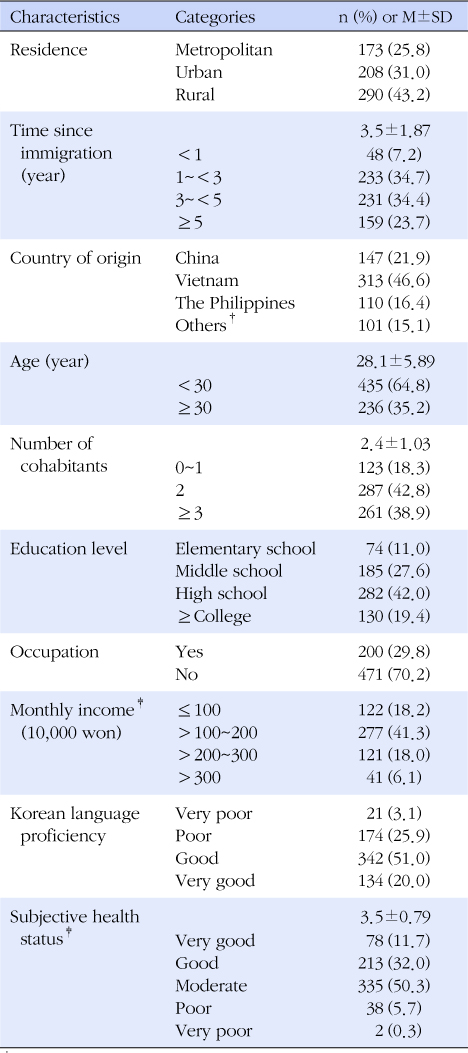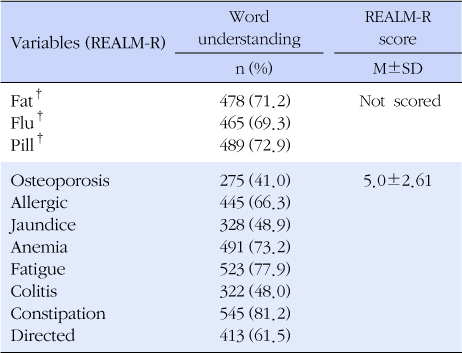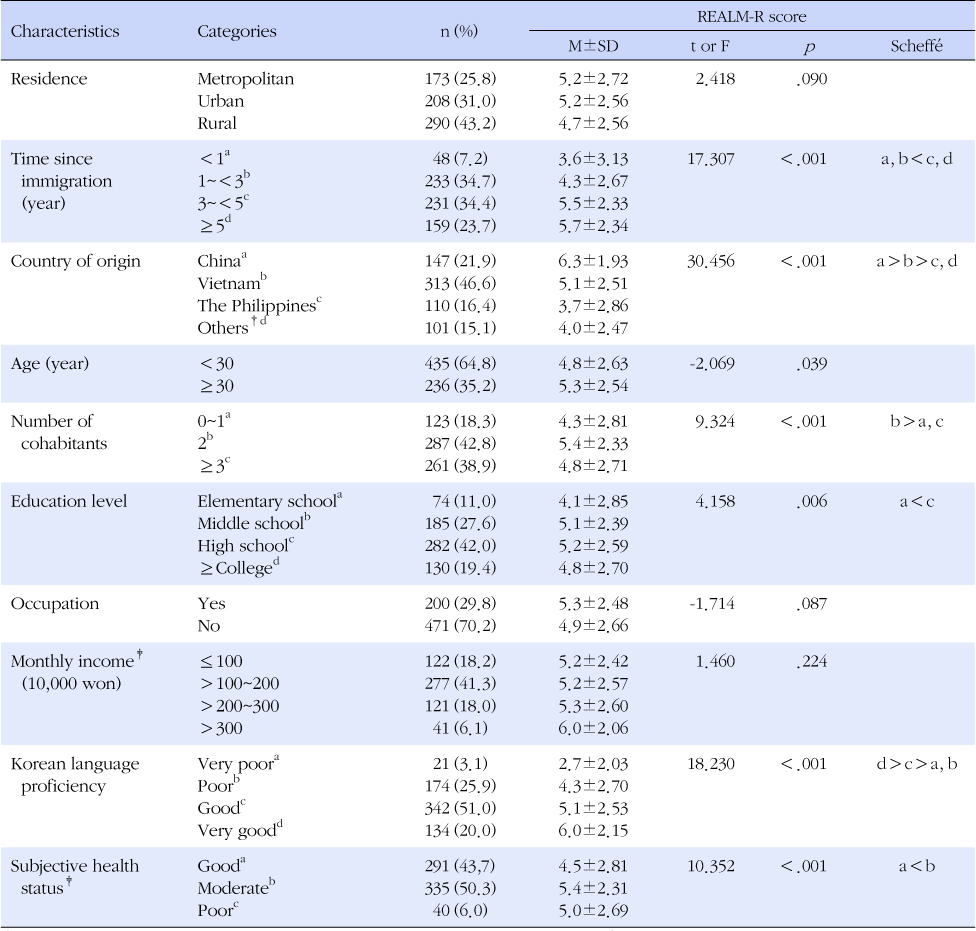Articles
- Page Path
- HOME > J Korean Acad Community Health Nurs > Volume 24(4); 2013 > Article
-
Original Article
- Factors related with Health Literacy in Asian Immigrant Women in Korea
- Jisook An, Hye-Ryun Kim, Sook Ja Yang
-
Journal of Korean Academy of Community Health Nursing 2013;24(4):377-387.
DOI: https://doi.org/10.12799/jkachn.2013.24.4.377
Published online: December 31, 2013
1Division of Nursing Science, College of Health Sciences, Ewha Womans University, Seoul, Korea.
2Korea Institute for Health and Social Affairs, Seoul, Korea.
• Received: August 14, 2013 • Revised: November 18, 2013 • Accepted: December 11, 2013
© 2013 Korean Academy of Community Health Nursing
This is an Open Access article distributed under the terms of the Creative Commons Attribution Non-Commercial License (http://creativecommons.org/licenses/by-nc/3.0/) which permits unrestricted non-commercial use, distribution, and reproduction in any medium, provided the original work is properly cited.
- 537 Views
- 1 Download
- 8 Crossref
Abstract
-
Purpose
- The purpose of this study is to identify health literacy levels of Asian immigrant women in Korea and factors related with health literacy in them among other sociodemographic characteristics.
-
Methods
- Data were drawn from 671 immigrant women who came from China, Vietnam, the Philippines, and other Asian countries (M age=28.1±5.89) using REALM-R, which consisted of 8 medical words and was translated into Korean (score range: 0~8). Data were analyzed using SPSS/WIN 20.0 program for descriptive statistics, t-test, ANOVA, Scheffé test and multiple regression.
-
Results
- The average score of health literacy was 5.0±2.61. Time since immigration, country of origin, education level, and Korean language proficiency significantly predicted levels of health literacy in Asian immigrant women (adjusted R square=.200, p<.001).
-
Conclusion
- When health care professionals provide health care services and health education, they should consider levels of health literacy and factors related with health literacy in Asian immigrant women.
-
This research was supported by Korea Health Promotion Foundation funded by the Ministry of Health & Welfare.
NOTES
- 1. Ad Hoc Committee on Health Literacy for the Council on Scientific Affairs. Health literacy: Report of the council on scientific affairs. JAMA. 1999;281(6):552–557. ArticlePubMed
- 2. Andrus MR, Roth MT. Health literacy: A review. Pharmacotherapy. 2002;22(3):282–302. ArticlePubMed
- 3. Bass PF, Wilson JF, Griffith CH. A shortened instrument for literacy screening. J Gen Intern Med. 2003;18(12):1036–1038. ArticlePubMedPMC
- 4. Cohen J. Statistical power analysis for the behavioral sciences. 2nd ed.Hillsdale, NJ: Lawrence Erlbaum Associates; 1988.
- 5. Davis TC, Long SW, Jackson RH, Mayeaux EJ, George RB, Murphy PW, et al. Rapid estimate of adult literacy in medicine: A shortened screening instrument. Fam Med. 1993;25(6):391–395. PubMed
- 6. Garbers S, Chiasson MA. Inadequate functional health literacy in Spanish as a barrier to cervical cancer screening among immigrant Latinos in New York city. Prev Chronic Dis. 2004;1(4):A07.
- 7. Institute of Medicine. Health literacy: A prescription to end confusion (2004004829). Washington DC: The National Academies Press; 2004.
- 8. Jastak S, Wilkinson GS. Wide range achievement test-revised 3. Wilmington, DE: Jastak Associates; 1993.
- 9. Jeong KW. A study on the linguistic ability and cultural adaptation of female married immigrant in Korea. Teach Korean Foreign Lang. 2009;34:89–111.
- 10. Kim HR, Hwang NM, Chang IS, Yoon KJ, Kang BJ. Reproductive Health Status And Policy Agenda Among Marriage Immigrant Women In Korea (2008-66). Seoul: Korea Institute for Health and Social Affairs; 2008.
- 11. Kim HR, Yeo JY, Jeong JJ, Baek SH. Health status of marriage immigrant women and children from multicultural families and health policy recommendations (2012-10). Seoul: Korea Institute for Health and Social Affairs; 2012.
- 12. Kim SK, Kim YK, Cho AJ, Kim HR, Lee HK, Seol DH, et al. A survey on multicultural families in South Korea (2010-06). Seoul: Ministry of Health, Welf Fam Affairs, Ministry of Justice, Ministry of Gend Equality, Korea Inst Health soc Affairs; 2009.
- 13. Kim SS, Kim SH, Lee SY. Health literacy: Development of a Korean health literacy assessment tool. J Korean Soc Health Educ Promot. 2005;22(4):215–227.
- 14. Korea Centers for Disease Control and Prevention. Marriage immigrants and international collaboration cohort II. Seoul: Ewha Womans University; 2011.
- 15. Korea Immigration Service. Annual statistics 2012. Seoul: Author; 2013.
- 16. Kreps GL, Sparks L. Meeting the health literacy needs of immigrant populations. Patient Educ Couns. 2008;71(3):328–332. ArticlePubMed
- 17. Lee HS, Park HJ, Lee SJ. A study on the adult literacy in Korea and international comparative survey among OECD countries. Korean J Comp Educ. 2003;13(2):193–219.
- 18. Lee SH, Chang KH, Han HS, Park BK, Kim SS. The relationship of health literacy of female married migrants in Busan with their attitudes towards health. Female Stud. 2012;22(1):165–200.
- 19. Lee SH, Choi EHR, Je MJ, Han HS, Park BK, Kim SS. Comparison of two versions of KHLAT for improvement strategies. Korean J Health Educ Promot. 2011;28(3):57–65.
- 20. Lee TW, Kang SJ. Health literacy in the Korean elderly and influencing factors. J Korean Gerontol Soc. 2008;28(4):847–863.
- 21. Ministry of Government Legislation. Multicultural families support act 2013;Retrieved June 15, 2013. from the http://www.law.go.kr/lsSc.do?menuId=0&p1=&subMenu=1&nwYn=1&query=%EB%8B%A4%EB%AC%B8%ED%99%94%EA%B0%80%EC%A1%B1%EC%A7%80%EC%9B%90%EB%B2%95&x=49&y=11#liBgcolor1
- 22. Ministry of Health and Welfare. Guidelines for community health promotion project. Seoul: Author; 2013.
- 23. Nguyen GT, Bowman MA. Culture, language, and health literacy: Communicating about health with Asians and Pacific islanders. Fam Med. 2007;39(3):208–210. PubMed
- 24. Park JY, June KJ. Influencing factors on functional health literacy among the rural elderly. J Korean Acad Community Health Nurs. 2011;22(1):75–85. Article
- 25. Ratzan S, Parker RM. Introduction. In: Selden CR, Zorn M, Ratzan S, Parker RM, editors. Current bibliographies in medicine: Health literacy. Bethesda, MD: National Library of Medicine; 2000. p. 5–7.
- 26. Song ES, Choi YR. Maternal and perinatal problems and prognosis of newborns in marriage immigrant women In: Paper presented at the meeting of the Korean Society of Maternal and Child health; Seoul. 2008;11.
- 27. Yang SJ. Health status, health care utilization and related factors among Asian immigrant women in Korea. J Korean Acad Public Health Nurs. 2010-a;24(2):323–335.
- 28. Yang SJ. Prevalence and risk factors of anemia among Asian immigrant women in Korea. J Korean Data Anal Soc. 2010-b;12(5):2579–2593.
- 29. Yang SJ, Kim JA, Kim SN, Choi HY, Park CS, Dahn HJ. Health concept, health status and health service utilization of marital immigrant women in urban and rural areas in Korea (09-37). Seoul: Ewha Womans University, Management Center for Health Promotion; 2009.
- 30. Yang YM, Wang H. Life and health concerns of Indonesian women in transnational marriage in Taiwan. J Nurs Res. 2003;11(3):167–176. PubMed
Figure & Data
References
Citations
Citations to this article as recorded by 

- Influence of Perceived Health Status, Perceived Barrier, Cultural Acculturation on Empowerment in Married Migrant Women
Yong-Sook EO, Yeon Hee LEE
JOURNAL OF FISHRIES AND MARINE SCIENCES EDUCATION.2020; 32(5): 1308. CrossRef - Health literacy among Saudi population: a cross-sectional study
Mohamed M M Abdel-Latif, Sherif Y Saad
Health Promotion International.2019; 34(1): 60. CrossRef - Associations of health belief and health literacy with Pap smear practice among Asian immigrant women
Yong-Sook Eo, Ji-Soo Kim
European Journal of Oncology Nursing.2019; 42: 63. CrossRef - Effectiveness of Psychosocial and Educational Prenatal and Postnatal Care Interventions for Married Immigrant Women in Korea: Systematic Review and Meta-analysis
Sun Kyung Kim, Seyeon Park, Sukhee Ahn
Asia Pacific Journal of Public Health.2017; 29(5): 351. CrossRef - Analysis of Validity and Reliability of the Health Literacy Index for Female Marriage Immigrants (HLI-FMI)
Sook Ja Yang, Yeon Kyung Chee, Jisook An, Min Hee Park, Sunok Jung
Asia Pacific Journal of Public Health.2016; 28(4): 368. CrossRef - Evidence-based health literacy improvements: trends on health literacy studies in Korea
Soo Jin Kang, Mi Sook Lee
Korean Journal of Health Education and Promotion.2015; 32(4): 93. CrossRef - Health Literacy and Its Associated Factors in Korean-Chinese and Other Asian Immigrant Women in Korea
Sook Ja Yang, Yeon Kyung Chee, Jisook An, Min Hee Park, Sunok Jung
Journal of Korean Public Health Nursing.2014; 28(2): 211. CrossRef - A Study on Health Education Needs of the Multicultural Family as Perceived by Visiting Nurses
Young Sil Kang, Eunyoung Hong
Journal of Korean Public Health Nursing.2014; 28(3): 445. CrossRef

 KACHN
KACHN




 PubReader
PubReader Cite
Cite

